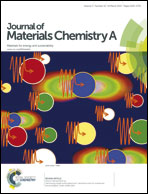Mushroom-like Au/NiCo2O4 nanohybrids as high-performance binder-free catalytic cathodes for lithium–oxygen batteries†
Abstract
Li–O2 (or Li–air) batteries currently represent a hot topic in the field of energy storage and conversion. The electrochemical performance of the Li–O2 battery depends largely on the material and architecture of the catalytic cathode. In this work, we propose a unique design of a binder-free catalytic cathode for Li–O2 batteries. The electrode consists of a novel mushroom-like Au/NiCo2O4 nanohybrid on three-dimensional graphene (3D-G) grown directly on the skeleton of Ni foam. The Au/NiCo2O4/3D-G catalyst exhibits a good catalytic effect for Li–O2 batteries, where Au directs the growth of Li2O2 mainly on the top of mushroom-like Au/NiCo2O4, and induces the crystallization of Li2O2 into the thin-flake or thin-film form that is found to decompose relatively easily compared with the large-particle form upon charging. Mushroom-like NiCo2O4 provides additional catalytic sites and acts as the support for both Au and Li2O2. A Li–O2 battery with the Au/NiCo2O4/3D-G catalyst can deliver a capacity of around 1275 mA h g−1 at 42.5 mA g−1. When the capacity is limited at 510 mA h g−1, the Li–O2 battery can sustain stable cycling up to 40 times.


 Please wait while we load your content...
Please wait while we load your content...